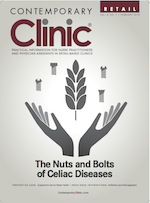The Nuts and Bolts of Celiac Disease
Gluten proteins found in barley, rye, and wheat trigger systemic injury primarily to the small intestine, but they can also affect the joints, liver, skin, uterus, and other organs.
Celiac disease (CD) is a chronic condition classified as an autoimmune disorder. Gluten proteins found in barley, rye, and wheat trigger systemic injury primarily to the small intestine, but they can also affect the joints, liver, skin, uterus, and other organs.1The only available treatment for CD is adherence to a gluten-free diet (GFD). The occurrence rate of CD is thought to be underestimated. The reported prevalence of CD in children globally ranges from 0.31% to 0.9% and from 0.4% to 0.95% for adults in the United States.2
From 2009 to 2014, those 6 and older undergoing serologic testing for CD with a prior diagnosis of the disease and the use of a GFD, confirmed by direct interview, participated in a National Health and Nutrition Examination Survey study.3Findings suggest that the prevalence of CD has remained stable in the United States, though people are increasingly following a GFD without a confirmed diagnosis.
Here are some thoughts on what may be contributing to the increasing popularity of a GFD:
• Gluten-free products used to be hard to find but have become more widely available. 

• Public perception is that GFDs are healthier than traditional diets and may provide benefits for nonspecific gastrointestinal symptoms. 

• There is an increasing number of individuals with self-diagnosed gluten sensitivity without a diagnosis of CD who have experienced improved symptoms on a GFD.3

A number of medications are undergoing early testing to improve the prognosis of CD or to allow patients to consume foods with gluten. But until those are approved, educated patients need to understand the importance of adhering to a GFD. Evidence shows that a GFD will improve symptoms, though there is a lack of convincing evidence that the diet protects against all comorbidities and complications.1 

How can clinicians improve patient adherence? Adherence is strongly linked to knowledge and understanding. Begin by educating the patient on the function of the small intestine, which is made up of villi that absorb nutrients into the bloodstream. Gluten is a protein that damages villi in patients with CD. Without the ability to absorb nutrients, the body can develop other conditions from malabsorption such as other autoimmune disorders, cancer, infertility, osteoporosis, and thyroid disease.4Showing pictures of abnormal and normal mucosa can help illustrate the effect that gluten has on the small intestine. It is important to also stress with patients that adhering to a GFD improves the potential of healing the mucosa, thus improving the symptoms of CD. Although patients generally feel better on a GFD, not all symptoms will resolve in all patients. For most patients, diarrhea will respond within 4 weeks, but it could take up to 6 months, and a small number of patients will continue to have persistent diarrhea.1
Without getting into a detailed lesson in genetics, clinicians can help the patient understand why some people are at risk for getting CD while others are not, that environmental factors only contribute to the risk of CD, and that comorbidities in CD, some of which are not preventable, may occur both before and after diagnosis.1
Patients will need detailed information on how to read the labels of processed food and ideally should be given a referral to a dietitian. It can help to focus the patient on a list of grains and other starch-containing foods that are naturally gluten-free: These include amaranth, arrowroot, beans, buck wheat groats (also known as kasha), cassava, chia, corn (maize), flax, gluten-free oats, millet, nut flours, potato, quinoa, rice, sorghum, soy, tapioca, teff, and yucca.5
CD can also affect social behaviors. Patients with CD may have to pass on dinner invitations, for instance, if they are afraid that they will not be able to eat the food served. Teenagers for whom belonging to a group and not standing out is of high importance are at higher risk for poor dietary adherence. There is clear evidence that patients with CD are less likely to dine out in restaurants or at friends’ houses because of concerns regarding cross-contamination or inadvertent exposure to gluten.1The Celiac Foundation (celiac.org) provides additional information for patients and health care professionals.
Kristen Marjama, DNP, FNP-BC, is a doctorally prepared family nurse practitioner with 9 years of experience in the
retail health industry. She is the manager of clinic education and professional development at Walmart Care Clinic in Fort Lauderdale, Florida
References
1.http://journals.sagepub.com/doi/pdf/10.1177/2050640614562599
2.https://www.medscape.com/viewarticle/720681_2The Spectrum of Celiac Disease: Epidemiology, Clinical Aspects and Treatment
3. JAMA Internal Medicine November 2016 Volume 176, Number 11. Time Trends in the Prevalence of Celiac Disease and Gluten-Free Diet in the US Population: Results from the National Health and Nutrition Examination Surveys 2009-2014. Pages 1716-1718.
5.https://celiac.org/live-gluten-free/glutenfreediet/food-options/

